Small Group Experiential Travel
Tour Code
SA5
Start
Johannesburg (JNB)
End
Windhoek (WDH)
Tour type
Cultural
Max Group Size
18
When To Go
Feb, Oct
Activity Level
1 - Light
Overnight in
Cape Town, Johannesburg, Port Elizabeth, Oudtshoorn, Knysna, Mbabane, Hazyview, Hluhluwe, Windhoek, Namib-Naukluft National Park, Swakopmund, Twyfelfontein, Etosha National Park
- Overview
- Info & Inclusions
- Itinerary
- Map & Hotels
- Photos
- Dates & Prices
Highlights
- Kruger Park safari
- Kingdom of Eswatini (Swaziland): Switzerland of Africa
- Table Mountain Cable Way
- Robben Island Museum
- The Namib, world's oldest desert
- Rugged Skeleton Coast
- Etosha: Africa's undiscovered wildlife gem
Description
Our South Africa & Namibia Tour begins in the capital of South Africa - Johannesburg - and traces of its history stand out at every turn of the corner.
The area is still brimming with reminders of the colonial era; a period that saw immense growth upon the discovery of gold in the area.
Seeing examples of European influence as we pass through the many Gold Rush towns, such as the traditional Cape Dutch architecture of Stellenbosch or the many wineries of the surrounding area, is not restricted to South Africa.
As soon as we arrive in Windhoek, Namibia, we instantly realize it has a distinctly German feel to it.
Namibia offers more than an intricate history; it offers an immense track of land shining in full beauty.
Covering a record 5,000 square kilometres, Naukluft National Park is the largest conservation area in the world and we will feel the simple pleasure of having sand beneath our bare feet as we climb the famous Sossusvlei sand dunes, which also hold world records for their size.
The area is still brimming with reminders of the colonial era; a period that saw immense growth upon the discovery of gold in the area.
Seeing examples of European influence as we pass through the many Gold Rush towns, such as the traditional Cape Dutch architecture of Stellenbosch or the many wineries of the surrounding area, is not restricted to South Africa.
As soon as we arrive in Windhoek, Namibia, we instantly realize it has a distinctly German feel to it.
Namibia offers more than an intricate history; it offers an immense track of land shining in full beauty.
Covering a record 5,000 square kilometres, Naukluft National Park is the largest conservation area in the world and we will feel the simple pleasure of having sand beneath our bare feet as we climb the famous Sossusvlei sand dunes, which also hold world records for their size.
Price Includes
- Breakfast and dinner daily
- Most meals in Namibia.
- All accommodation, transport (including internal flights), sightseeing and entrance fees for sites noted as 'visited' in the detailed itinerary.
- Gratuities for drivers, local guides, restaurant staff, porters.
- Airport transfers for land & air customers arriving/departing on tour dates.
Exclusions
- International airfare to/from the tour.
- Tour Leader gratuities, most lunches, drinks, personal items (phone, laundry, etc), and any excursions referenced as 'optional'.
- Airport transfers for Land Only customers.
- Optional trip cancellation insurance.
- Our post-reservation trip notes offer further guidance on shopping, visas, and locally paid departure taxes.
Trip Info
- Seasonality and Weather:
SOUTH AFRICA:
Oct/Nov - Short-lived thunderstorms are a frequent occurrence, especially in the north.
Dec/Jan: Mid-summer and heat is a factor, especially in the north, though game reserves are green.
Feb-April is late summer when days are usually hot with thunderstorms in the north and dry, cooler weather in the south.
June/July coincides with "winter" in Southern Africa-warm and dry days and cool-cold nights in the northern regions. Game parks are dry and cool with short grasses that enhance game spotting. In the Cape weather conditions can be highly changeable with wind and rain possible.
NAMIBIA:
November to April:
The ‘rainy’ season is during the summer months, from November to April. The weather tends to be hot and humid with dramatic afternoon thunderstorms. However, the downpours are short and heavy, so it's unlikely that the rain will disrupt your travel plans -- meaning that you don't have to worry about when to go to Namibia because even the rainy season is a great time to visit. March can also be a good time to visit Namibia's Etosha National Park; following the birthing season in January and February, you will be able to see young animals taking their first steps in the wild. That said, the lush vegetation seen in March to May can make game viewing more challenging.
June to October:
The ‘dry’ season takes place during the winter months from May to October and the weather is typically warm and sunny, albeit with very cold nights. These months are considered to be the best time to go to Namibia, as you can enjoy uninterrupted blue skies and plenty of sunshine, except along the coast where there is often a fog. The daytime temperatures during these months are moderate, however it can get very cold in the evenings.
In terms of wildlife, the dry winter months (June-August) are ideal for game viewing in Etosha National Park because the vegetation is sparse and water sources dry out. Therefore, the local wildlife gathers around the permanent water holes, making animals easier to locate, observe and photograph. - Transport and Travel Conditions:
SOUTH AFRICA:
Land transport provided via air-conditioned motor coach, the ultimate size of which may vary depending on group size (see 'Group Size'). We use open "safari" 4x4 vehicles in Kruger. We have some full-yet-scenic bus days, though, stops at points of interest and for the sake of comfort are frequent and roads are excellent. Our internal flights are provided by scheduled local carriers.
NAMIBIA:
Land transport in Namibia is via specialized 4x4 safari vehicles, equipped with air-conditioning and fridges for drinks and snacks.
All vehicles are equipped with:
• Roof pop-tops for better photography and game viewing vantage points
• Air-conditioning
• Onboard fridge/freezers and plenty of water.
• Personal library, which includes a series of guidebooks, maps, stationery and checklists.
• 220-volt electrical charging point, to charge electrical devices whilst travelling.
• Guaranteed window seat on every safari.
• VHF inter-vehicle radios that allow multi vehicle groups to communicate with each other while ‘on the road’
Namibia is a huge, sparsely-populated country with great distances between facilities. We stop for breaks as often as possible, but you must be prepared for some long days and some early starts.
Our transport in Botswana will be of a similar nature for our game drives in Chobe and road journeys.
Though baggage handling is available at hotels and is included in your tour, you still need to be able to manage your own luggage, especially at airports.
Am I suitable for this tour? Please refer to our self-assessment form - Accommodation:
All of our hotels are modern, well-located and managed mid-range (ie 3-4 star) properties with private en-suite bath.
Please click on the "Map & Hotels" tab for more information.
In South Africa, at Victoria Falls, and in Swaziland, our hotels are modern, well-located and managed mid-upper range (ie 3-4 star) properties with private en-suite bath.
In Namibian towns and cities, our hotel choices will be much like as described above for South Africa, while lodges elsewhere in remote areas often feature stunning locations and plenty of local atmosphere. - Activity Level: 1
No particular physical activity is involved other than town/city walks and short walks to dinners and sites of interest, some of which are large.
To learn more about the Activity levels, please visit our tour styles page. - Staff and Support:
Tour Leader throughout South Africa; drivers, local guides at various locations. Local leader in Namibia. - Group Size:
Maximum 18 plus Tour Leader
Download Itinerary
- Day 1:Arrive in JohannesburgArrival in Johannesburg. We transfer to our hotel in Sandton, a suburb north of Jo'burg.
Johannesburg is South Africa's financial centre and largest city. This "Place of Gold", as the Sotho word for Gauteng Province suggests, harbours the gold fields of South Africa. No one could have imagined the repercussions when an unemployed miner found a stone bearing traces of gold in 1886. This seemingly insignificant event led to the discovery of the world's richest natural treasure trove. People flocked to the area from all ends of the earth and the open pastoral landscape changed almost overnight. Today in the "New South Africa," Johannesburg continues as the country's -- indeed the entire region's -- economic powerhouse and is evolving into a very vibrant cultural melting pot.
Overnight in Johannesburg (Sandton).
Included Meal(s): Dinner - Day 2:Johannesburg & SowetoThis morning we have a tour of the city of Soweto.
Soweto unto itself is actually one of the largest cities in Africa with an estimated population of two million. It also has one of the most dubious histories of any city in Africa, as it was the site of some of the more infamous events during the struggle against apartheid. The name "Soweto" simply stands for South Western Township, due to its location outside Johannesburg. It was here that thousands of black workers were forced to live in order to provide labour for the gold mines.
We will see the good, the bad, and the ugly of Soweto -- from affluent neighbourhoods to shanty towns, one of the world's largest hospital, Baragwanath; and the former homes of Soweto's Nobel Laureates, Desmond Tutu and Nelson Mandela. We also visit the Hector Pietersen memorial where we will learn of the 1976 Soweto Uprising.
A compelling highlight of our day is our visit to the extraordinarily powerful Apartheid Museum, an obligatory stop for visitors and residents alike. The large blown-up photographs, metal cages and numerous monitors with continuous replays of apartheid scenes will make you feel that you were in the townships in the 70s and 80s, dodging police bullets or teargas canisters, or marching with thousands of school children.
We'll also be able to have a panoramic view of central Johannesburg before circling back around to Sandton and our hotel.
Overnight in Johannesburg (Sandton).
Included Meal(s): Breakfast and Dinner - Day 3:Johannesburg - the 'Panoramic Route' - HazyviewFrom Jo'burg we head off through the vast wilderness of Mpumalanga (formerly the Eastern Transvaal), the "Land of the Rising Mist". Along the way we travel from the vast grasslands of the High Veld, with its huge farms and ranches, down to the drier Low Veld region characterized by rocky hills and acacia scrub forest. This is an expansive landscape of mountains, valleys, rivers, waterfalls, primal forests, and colourful flora. Steeped in a history of pioneers and fortune-seekers, we will pass many Gold Rush towns and farming communities en route. Lydenburg ("town of suffering") established by Voortrekkers in 1849 lies at the bottom of Long Tom pass. This pass, named after the big gun used by the Afrikaners during the Anglo Boer War, is one of the most scenically dramatic in the country. It links Sabie on the escarpment with Lydenburg on the Drakensberg plateau.
A highlight of our sightseeing today is the spectacular Blyde River Canyon. This great escarpment is the kind of place where brochures and guide books run out of original adjectives to describe the fresh mountain scenery and magnificent panoramic views. The Blyde River Canyon is one of the most spectacular in Africa and its cliffs rise between 600-800 m (2,000-2,640 feet) from the river bed. At the "Three Rondavels viewpoint" is an unforgettable view of three huge rock spirals rising out of the far wall of the canyon. Their tops appear to have a hut-like rounded roof.
We also stop at the nearby Bourke's Luck Potholes, the result of decades of swirling eddies of water where the Treur River meets the Blyde River. The tumult has caused extensive water erosion over time; the result is a series of cylindrical rock sculptures that look as though they would be more comfortable on the moon.
From here we continue to Hazyview near Kruger National Park.
Overnight in Hazyview.
Included Meal(s): Breakfast and Dinner - Day 4:Kruger National ParkEarly this morning we enter South Africa's largest game reserve, Kruger National Park, named after Paul Kruger, the first to initiate the setting aside of this area as a reserve in the 1890s. Here we transfer to open safari vehicles and make a full-day excursion through the southern sector of this fascinating and beautiful park.
The Kruger Park is an enormous area of flat veld, broken by rivers and comprised of mixed vegetation and terrain. The park, officially founded in 1926, supports more species of wildlife than any other African reserve -- over 137 mammal species, 49 fish species, 112 reptile species, and nearly 500 bird species! With some luck we may see and photograph lion, leopard, cheetah, elephant, zebra and many other wonderful African animals.
We return to Hazyview in the late afternoon.
Overnight in Hazyview.
Included Meal(s): Breakfast and Dinner - Day 5:Hazyview, South Africa - Mbabane, Eswatini (Swaziland)We travel south today en route to the Kingdom of Eswatini (formerly Swaziland), an independent country completely landlocked by South Africa and Mozambique, and smaller than Kruger Park! Just before we cross the border, however, we'll visit the Matsamo Cultural Village, a traditional Swazi village that showcases the country's rich cultural heritage. We'll take a guided tour of the village, learning about the customs and traditions of the Swazi people. We'll also enjoy a traditional lunch and have the opportunity to interact with the villagers. This visit will provide a unique glimpse into Swazi culture and daily life.
As we enter the Kingdom of Eswatini, we'll be struck by the country's natural beauty, with majestic mountains forming a stunning backdrop to our journey. One of the last remaining monarchies in Africa, Eswatini offers a unique glimpse into traditional African culture, where the pace of life is relaxed and the lifestyle remains largely unchanged. As we make our way to the vicinity of Mbabane, the capital city, we'll pass through picturesque rural landscapes, where we'll see local people tending to their farms and herds, living in harmony with the land. This tranquil scenery provides a serene introduction to the country's rich cultural heritage.
Before arriving at our hotel, we'll visit the renowned Ngwenya Glass, a pioneering glassblowing institution that has been creating exquisite glass art since the 1980s. Founded as a Swedish aid initiative, Ngwenya Glass has evolved into a thriving enterprise that not only produces stunning glassworks but also supports local conservation programs. What's more, all of the glass art is crafted from 100% recycled glass, reflecting the organization's commitment to sustainability. We'll hope to have the opportunity to witness the skilled artisans at work, shaping and blowing glass into intricate and beautiful forms.
Overnight in/near Mbabane.
Included Meal(s): Breakfast and Dinner - Day 6:Mbabane, Eswatini - Mkuze Game Reserve, South AfricaThis morning we depart our hotel and travel south, descending onto the Swazi Lowveld (lowlands), similar in climate and vegetation of the lowveld region we experienced in South Africa and Kruger Park in previous days. Before leaving the kingdom, we'll visit Swazi Candles, a candle making manufacturer both of both traditional parafin wax as well as 100% organic soya candle tea lights. The colourful, handmade product range also features wax encased LED lights, pure vegetable glycerine soaps, and marula oil bodybalm. Guests are invited to interact with the artisans as they work their magic.
We'll then travel through sugar cane plantations and the bustling commercial centre of Manzini, before crossing the border back into South Africa and the province of KwaZulu-Natal.
Our destination is Mkuze Game Reserve, which boast an exceptional variety of natural habitats: from the Eastern slopes of the Lebombo Mountains along its eastern boundary, to broad stretches of acacia savannah, swamps and a variety of woodlands and riverine forest. A rare type of sand forest also occurs in the reserve. It is renowned among ornithologists, with more than 420 different bird species on record. The Mkuze River curves along the game reserve's northern and eastern borders with a stretch of fig forest along its banks. Fish eagles swoop over the pans, snatching prey spotted from their perches in the fever trees.
Mkuze is overlooked by Ghost Mountain, previously a historic battle field. This mountain is said to be the tombs of the previous chiefs of the mountain and, according to legend, it has been the scene of a number of bloody fights. With its dramatic silhouette, in the shape of an old woman or witch head, it is not difficult to understand why the mountain is said to be haunted and to be the theatre of paranormal activities.
Overnight at Mkuze.
Included Meal(s): Breakfast and Dinner - Day 7:Mkuze - Hluluwle-iMfolozi Game Reserve - Fly to Gqeberha (Port Elizabeth)This morning we leave Mkuze and head to Hluhluwe-Imfolozi Park, the oldest proclaimed nature reserve in Africa. The park is known for its rich wildlife and conservation efforts; this is the only state-run park in KwaZulu-Natal where all of the "big five" wild animals can be found (elephant, rhino, lion, buffalo and leopard).
We continue by road to Durban, the 'Garden City' of South Africa. This area was opened up to white settlement by the Voortrekkers in the early 19th century, though the Portuguese were navigating the coast here as early as the late 15th century. Vasco da Gama was the first European to sail along this coast, giving it the name Natal to commemorate his Christmas Day arrival. In 1899 the British and the Boers went to war, but under reconciliation in 1910 formed the Union of South Africa with an agreement signed in what is now Durban's modern-day Main Post Office.
Flight time permitting, we may be able to drive through Durban for a quick look before heading to the airport for our flight to Gqeberha (Port Elizabeth)** South Africa's fifth largest city and the third largest port.
* Occasionally, due to ever-changing flight schedules, we may spend this night in Durban and take the early flight to Gqeberha tomorrow morning.
** In 2019, the Eastern Cape Geographical Names Committee recommended that Port Elizabeth be renamed Gqeberha, after the Xhosa and Southern Khoe name for the Baakens River that flows through the city. The pronunciation can be a bit tricky, as the "Q" represents a "click" sound with the tongue, then 'be' (like bare), and finally 'gha' (similar to the 'G' in Afrikaans + a short 'ah'). If it's easier, the town is also colloquially referred to as "PE."
Overnight in Gqeberha (Port Elizabeth).
Included Meal(s): Breakfast and Dinner - Day 8:Gqeberha - 'The Garden Route' - Knysna OR GeorgeThis morning we travel along the world-famous 'Garden Route' toward Knysna. This route is parallel to the ocean and features lakes, mountains, beaches, and steep cliffs. This part of the garden route reminds one of the Oregon Coast (USA) with its sand dunes and great surf beaches. We'll make a lunch stop at Storm's River Mouth in the Tsitsikamma National Park, located on the shores of the Indian Ocean. You will have time to walk a short section of the famed Otter Trail, widely regarded as one of the finest in the world, stretching 41 km (25 mi - 5 days) from Storms River Mouth to Nature's Valley.
We continue to Knysna, a charming coastal town with tremendous water and mountain views and a laid-back lifestyle. The town was founded in 1817 by George Rex, reputed to be an illegitimate son of King George III. Known for its picturesque lagoon, the town was first established as a timber port. Today, Knysna is proud of its riviera atmosphere with many sidewalk cafes and shops.
Depending on limited accommodation availability in Knysna, we may overnight here in Knysna or continue a little further down the road to the town of George.
Overnight in Knysna or George.
Included Meal(s): Breakfast and Dinner - Day 9:Knysna OR George - Mossel Bay - OudtshoornThis morning we travel down the coast to Mossel Bay. Portuguese explorer Bartolomeu Dias arrived here on February 3, 1488, thus proving to his sponsors that Africa had a southern tip; making it theoretically possible to sail from Europe to India. Our destination is the Dias Museum Complex, which marks the spot of the historical landing of Bartolomeu Dias. The 500 year old Post Office Tree, a national monument, can still be seen at the site, now harbouring a post box shaped as a shoe.
We then head inland and over the Outeniqua Mountains to the Little Karoo (Klein Karoo), a semi-arid yet fertile valley or depression surrounded by formidable mountain ranges. This is the ostrich capital of South Africa with thousands of these unusual birds dotting fields throughout the area. At the turn of the century ostrich feathers were in such demand that the fashion conscious paid a premium and feathered the nests of the barons who built magnificent mansions known as "Feather Palaces." This fine architecture can still be seen around the sedate and pleasant town of Oudtshoorn (pronounced 'Oats-horn'), our final destination.
Today we'll tour one of the ostrich "show farms" in the area before continuing to Oudtshoorn where we finish our day.
Overnight in Oudtshoorn.
Included Meal(s): Breakfast and Dinner - Day 10:Oudtshoorn - Swellendam - Cape TownFrom Oudtshoorn we travel through the Huis River Pass with its spectacular rock formations and the little farming town of Ladismith, named after the Spanish wife of British Cape Governor Sir Harry Smith. We cross our second mountain range of the day to arrive in the town of Swellendam, the third oldest colonial town in South Africa, established in 1745. The town has several buildings built in the charming Cape Dutch style, with characteristic whitewashed walls and black thatched roofs.
We then pass through a vast wheat growing and sheep farming area on our way to Cape Town.* In the late afternoon we cross the Hottentots Holland Mountains (our third range for the day), the centre of South Africa's apple growing region, to arrive in Cape Town, one of the world's most isolated and beautiful cities.
At some point during our time in Cape Town (weather dependent and may move elsewhere in our program), we will take a gondola trip to the top of Table Mountain, a sandstone plateau rising up above the city. The top is approximately 3km wide and at its highest point, Maclear's Beacon, rises to 1085m/3,580 ft. Over the centuries it has become one of South Africa's most famous landmarks. The steep cliffs and rocky outcrops of the mountain play home to a number of animals and approximately 1,470 species of plants -- more than the entire British Isles!
Overnight in Cape Town.
Included Meal(s): Breakfast and Dinner - Day 11:Cape Town: Robben Island & City TourThis morning we travel by boat to Robben Island for a guided tour of this historic site, formerly an infamous prison and today a museum. Our entire excursion will last about 3.5 hours and include a visit to the maximum security section where Apartheid era freedom fighters, including Nelson Mandela, were incarcerated. Robben Island provides a poignant reminder of how far South Africa has come since the dark days of apartheid and is a must-see for anyone heading to the Cape.
We'll also have a 'panoramic' look at the city centre of Cape Town, where we will see Parliament, City Hall, and the colourful Bo-Kaap area.
Overnight in Cape Town.
Included Meal(s): Breakfast and Dinner - Day 12:The Cape WinelandsThis morning we travel the short distance to Stellenbosch, South Africa's second oldest colonial settlement. After a little spin around the town, we'll park in the centre of town and allow some time for some independent, on-foot exploration. You will notice some of the finest examples of traditional Cape Dutch architecture along the town's famous oak-lined streets.
We continue to one of the area's many wineries for a cellar tour and tasting. The Cape vineyards were originated at Constantia by Jan van Riebeeck in 1685 and were advanced in 1688 by Hugenot refugees who brought their vine seedlings and skills with them from France. The Cape's different soils and climatic variations allow a wide variety of wines to be pressed. Along our route today we will see several wine estates with their delightful Cape Dutch houses, thatched roofs and decorative gables.
Today we include lunch at one of the area's wine estates. After lunch we'll continue our scenic drive through the area before heading back to Cape Town for dinner on your own. If weather permits, we'll attempt to head up Table Mountain upon return to the City Bowl.
Overnight in Cape Town.
Included Meal(s): Breakfast and Lunch - Day 13:Cape Town: the Cape PeninsulaToday we have the quintessential full-day tour of the Cape Town area: The Cape Peninsula.
Our tour takes us south along the Atlantic Seaboard where we have spectacular views of some of Cape Town's most affluent neighbourhoods and spectacular mountain and coastal scenery. We have a brief photo stop just before Camp's Bay, a pretty surf-side suburban community featuring the classic view of the town with the 'Twelve Apostles' peaks as a backdrop.
We continue south along a seaside-hugging route, through the town of Hout Bay and the famous Chapman's Peak Drive, one of the most spectacular marine drives anywhere in the world. The 9km route, with its 114 curves, skirts the rocky coastline of Chapman's Peak, the 593m high southerly extension of Constantia Berg.
Our next stop is the Cape of Good Hope Nature Reserve and Cape Point. The reserve is a wildflower, bird, and animal paradise on 77 sq km (30 sq miles) of the Cape Peninsula. The reserve is also home to eland, springbok, bontebok, baboon, and zebra. Within the reserve are Cape Point and the Cape of Good Hope, the most southwesterly point on the African continent.
After a break for lunch and free time at Cape Point, we head north again, stopping briefly at the Cape of Good Hope, before continuing back up the Indian Ocean side of the peninsula, passing through Simonstown, founded by the Dutch in 1741 as a naval depot and named for Simon van der Stel, governor of Cape Colony from 1679 to 1697. Today Simonstown is famous for its distinctly English architecture and atmosphere, and the southernmost train station on the continent. Depending on the season, we may stop at Boulders Beach to view a colony of South African penguins.
We complete our loop around the peninsula, past the well-watered eastern slopes of Table Mountain, Constantia, Bishop's Court and the campuses of the University of Cape Town. Here we pay a visit to the National Botanical Gardens of Kirstenbosch, with over 4,000 species of indigenous plants (2,600 are endemic to the Cape Peninsula). The garden's history dates back to the 1660s, when the first Dutch settlers arrived in the Cape. Governor Jan van Riebeeck planted a barrier of Wild Almonds to protect settlers' cattle from the original inhabitants of the area -- and part of this hedge is still in the garden!
Overnight in Cape Town.
Included Meal(s): Breakfast and Dinner - Day 14:Cape Town, South Africa - Fly to Windhoek, NamibiaToday we fly from Cape Town to Windhoek.
Flight schedules permitting, we will have a brief tour of Windhoek, a small, rather elegant city with a distinctly German feel about it, located in the country's central highlands. The city is full of trees and gardens, plus some splendidd buildings dating from the turn of the century, all jumbled up with post-modernist office blocks in a swirl of ethnic mix. The multicultural nature of Namibia is most evident on the streets, where you can see influences of the Wambo, Herero and Damara people, among many others. Remainder of the day for relaxation in some of the city's fine German konditerais (German-style pastry and bake shops) and/or shopping for souvenirs such as gemstones and tribal crafts.
Today you will meet our Namibia-based Tour Leader and enjoy a welcome dinner this evening.
Overnight in Windhoek.
Included Meal(s): Breakfast and Dinner - Day 15:Windhoek - Namib-Naukluft National ParkToday we leave the interior plateau region and head southwest through the Gamsberg Pass to the Namib Desert, through magnificent colours, pastel-basted rock formations, and waves of taupe-coloured grasses. Even the clouds are tinged orange-pink as distant dunes reflect their colour skywards. In the Nama language, Namib means vast, and this is an understatement. At the opposite end of the moisture scale is the parched Namib Desert with endless orange dunes blown into razor sharp ridges by the sand-shifting wind. The famous Sossusvlei sand dunes at 300m (1,000 ft), are the highest in the world, towering over their nearest rivals in Arabia, and just begging to be climbed barefoot.
Animals, insects, and plants have adapted to live in this generally inhospitable region and apart from infrequent rains, rely on the sea mist that rolls far inland. En route we have the chance to see kudu, springbok, gemsbok and black eagles set againstsome of the most expansive and dramatically rugged scenery in the world.
En route we have several stops for scenery viewing and photos. Upon arrival this afternoon you will have time to wander the land around our lodge and enjoy the multi-hued sands, strange twisted acacia trees, and almost guaranteed perfect sunset.
We will have a picnic lunch en route.
Overnight in the vicinity of the Namib-Naklauft National Park.
Included Meal(s): Breakfast, Lunch and Dinner - Day 16:Namib-Naukluft National ParkVery early this morning we drive into the park to a special place called Sossusvlei, a huge dried up pan (vlei) which sporadically holds water, at the base of some of the most spectacular dunes in the Namib. We watch the morning sun light up the apricot coloured sands, the long shadows accentuating the graceful, almost feminine curves of the dune crests.
These immense rich ochre sand dunes are one of the most wondrous sights in the world. Geologists say that this desert, covering most of the Namib-Naklauft Park, could be the oldest in the world. The older the dune, the brighter the colour from slow iron oxidisation and minute fragments of garnets. Dwarfed by the sheer size of the dunes, your footprints look like insect trails and each step forward forms a mini sand-slide. The solitude is immeasurable and your place in the great scheme of life takes on a curious insignificance. Visually powerful and deafeningly silent, this unforgettable experience is a high point of our visit to the Namib. Possible game sightings include oryx antelope, springbok, or ostrich.
At Sossusvlei we have plenty of time to walk into the heart of the dunes, scale a dune or two for panoramic views, and walk across the sand to a pan called Dead Vlei. This spooky place is named as such because of the blackened dead acacia trees that "sprout" from a blinding white pan against an orange dune backdrop. Stupendous.
On our way back to our accommodation we will make a stop at Sesriem Canyon, located near the entry gate to Sossussvlei. It was an important source of water for early inhabitants and even during dry times there is water in the upper reaches, where deep clefts in the rock reduce evaporation. Explorers, transport riders and early travellers used to lower a bucket
down to collect the water and it normally took 6 lengths of thong tied together, hence the Afrikaans name 'Ses' meaning six, and 'Riem' meaning thong. The canyon was formed by the Tsauchab River rising in the Naukluft and Zaris Mountains to the east, and flowing through to Sossusvlei. Walking through the canyon takes you on a journey back 10-20 million years ago
when sedimentary layers of gravel and sand were deposited and cemented together by lime. The ledges are now inhabited by pigeons, raucous pied crows and chattering starlings.
We'll have a picnic breakfast en route and likely a late lunch upon return to our lodge.
Overnight in the vicinity of the Namib-Naklauft National Park.
Included Meal(s): Breakfast, Lunch and Dinner - Day 17:Namib-Naukluft Park - SwakopmundWe continue our journey north through Namib-Naukluft Park via Solitaire and the spectacular rocky Kuiseb Canyon (photo stops en route) -- with possible sightings of baboon, rock hyrax, or, if lucky, leopard -- to the German colonial resort town of Swakopmund. This is Namibia's second biggest town and traditional "summer capital", and one of themost surreal places in this surreal country. You approach the town through the endless expanses of the Namib Desert, one of the world's largest wilderness areas. Then, through the mists (it is almost always misty in the morning and late afternoon) Bavarian spires and elaborate Germanic architecture rise through the fog banks. The boom of the surf on the notorious Skeleton Coast is an ever-present reminder of the icy Atlantic Ocean beyond.
We will have some time for a stroll around town before dinner.
Overnight in Swakopmund.
Included Meal(s): Breakfast, Lunch and Dinner - Day 18:Swakopmund: Leisure Time & Optional ActivitiesToday is free to wander the streets of charming Swakopmund. The town is an eclectic mixture of Bohemian and Bavarian, home to an intriguing mix of artists, hippies, strait-laced descendants of German settlers, stately Herero women in Victorian dress, and hardened miners, game rangers, safari operators and fishermen. Swakopmund exudes romance and history, a rich cultural melting pot of old and new. Nighttime entertainment ranges from sophisticated spins on the casino's roulette wheels, through raucous parties at the many pubs and restaurants, to an assortment of drama, music and cultural events. It is indeed odd to be in a little corner of old Bavaria wedged between one of the world's harshest deserts and even harsher coastlines.
You may wish to participate in an optional activity, including "Living Desert" excursions of the amazingly diverse Namib Desert biosphere; marine cruises on the Walvis Bay lagoon and outer harbour, scenic flights, camel rides, and many more (your Tour Leader can advise on current pricing and book in advance once you arrive on the tour).
Overnight in Swakopmund.
Included Meal(s): Breakfast and Dinner - Day 19:Swakopmund - DamaralandAfter an early breakfast the road takes us north and east into the wonderful and diverse region of Damaraland. We pass Namibia’s highest mountain, the Brandberg, which peaks at 2573 m above sea level, and take time to view game and absorb the vastness of the scenery along the way. Weu make our way into the heart of Damaraland where we will spend the next two nights at our specially erected Under Canvas Camp ("Huab Under Canvas").
Damaraland is typified by displays of colour, magnificent table-top mountains, rock formations and bizarre-looking vegetation. The present day landscape has been formed by the erosion of wind, water and geological forces which have created rolling hills, dunes, gravel plains and ancient river terraces. It is the variety and loneliness of the area as well as the scenic splendour which will reward and astound you, giving one an authentic understanding of the word 'wilderness'.
If time allows this afternoon (or tomorrow if we are running late) we will visit the nearby attractions and geological sites of the pre-historic Twyfelfontein rock engravings (recently declared a UNESCO World Heritage Site). We will arrive in the late afternoon after a long yet rewarding day -– with time to enjoy sundowners before dinner.
Overnight in Damaraland.
Included Meal(s): Breakfast, Lunch and Dinner - Day 20:Damaraland TouringToday is dedicated to exploring this remarkable and fascinating area with our guides. After an early breakfast we will be treated to a memorable 4x4 excursion along the ephemeral Aba Huab River valleys to explore this remarkable region and to search for game, including the elusive desert adapted elephants if they are in the area. Damaraland is home to a variety of desert adapted wildlife and hidden desert treasures. As the elephants are mostly active in the mornings we will normally have the best chance to see them then before returning to camp for lunch. However, if all avellers are in agreement, we could possibly take a picnic lunch and stop to enjoy that in the shade of a large Ana tree by the riverbed, ideally while watching a herd of elephant browsing nearby. On return to camp there should be time to relax and enjoy some pre-dinner drinks while admiring the stunning views of your surroundings at sunset.
Overnight in Damaraland.
Included Meal(s): Breakfast, Lunch and Dinner - Day 21:Damaraland - Etosha National ParkThis morning after breakfast we will continue our safari to Etosha National Park. Lunch is had en route and if time allows this afternoon our guide will take us on a game drive into Etosha, exiting the park before the gates close at sunset. The rest of the evening can be spent game viewing at the camp's floodlit waterhole.
Overnight at Etosha (West).
Included Meal(s): Breakfast, Lunch and Dinner - Day 22:Etosha National ParkToday is dedicated to a full day of exciting game viewing within the central and eastern sections of Etosha National Park from the comfort of our private safari vehicle/s. We drive our way from the southern Andersson’s Gate to Halali (where we may stop for lunch) and then on across via selected waterholes such as Goas, which are normally particularly good for
game viewing, to Namutoni Camp in the east, eventually leaving the park before sunset, arriving with enough time to relax and freshen up before for dinner.
Etosha National Park covers 22,270 km², of which approximately 5,000 km² is made up of saline depressions or 'pans'. The largest of these pans, the Etosha Pan, can be classified as a saline desert in its own right. The Etosha Pan lies in the Owambo Basin, on the north-western edge of the Namibian Kalahari Desert. Until three million years ago it formed part of a huge, shallow lake that was reduced to a complex of salt pans when the major river that fed it, the
Kunene, changed course and began to flow to the Atlantic instead. If the lake existed today, it would be the third largest in the world. Etosha is the largest of the pans at 4,760 km² in extent. It is nowadays filled with water only when sufficient rain falls to the north in Angola, inducing floods to flow southward along the Cuvelai drainage system.
The park consists of grassland, woodland and savannah. Game-viewing centers on the numerous springs and waterholes where several different species can often be seen at one time. The park boasts some 114 mammal and over 340 bird species. Wildlife that one might see includes elephant, lion, giraffe, blue wildebeest, eland and kudu.
Overnight Etosha (East).
Included Meal(s): Breakfast, Lunch and Dinner - Day 23:Etosha National ParkFull day of exciting game viewing within the eastern section of Etosha National Park. Our day and lunch placement are somewhat free-form to take into account seasonal variations, weather, and travellers' interest.
Overnight at Etosha-East.
Included Meal(s): Breakfast, Lunch and Dinner - Day 24:Etosha - WindhoekAfter a leisurely breakfast we set off on our journey back to Windhoek. The road takes us south through Namibia's central highlands and commercial farmlands to reach Windhoek for the last night of our safari. We can visit Lake Otjikoto along the way and spend some time in Okahandja at the local woodcarver’s craft market where you can do some last minute curio shopping if desired.
Overnight in Windhoek.
Included Meal(s): Breakfast, Lunch and Dinner - Day 25:DepartureToday we depart from Windhoek.
BON VOYAGE!
Included Meal(s): Breakfast
Regions Visited: Southern Africa
Countries Visited: Swaziland, Namibia and South Africa
Countries Visited: Swaziland, Namibia and South Africa
*The red tour trail on the map does not represent the actual travel path.
The following is a list of sample hotels at some locations included on this tour. The hotels shown here are meant to provide a general sense of the standard of hotel we usually aim for; they are not necessarily confirmed for your chosen departure.
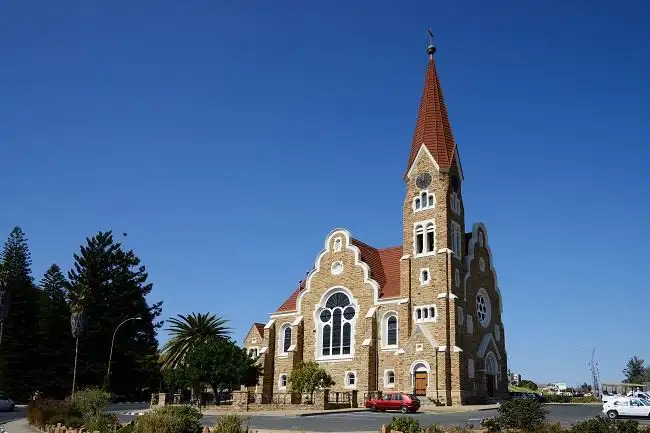
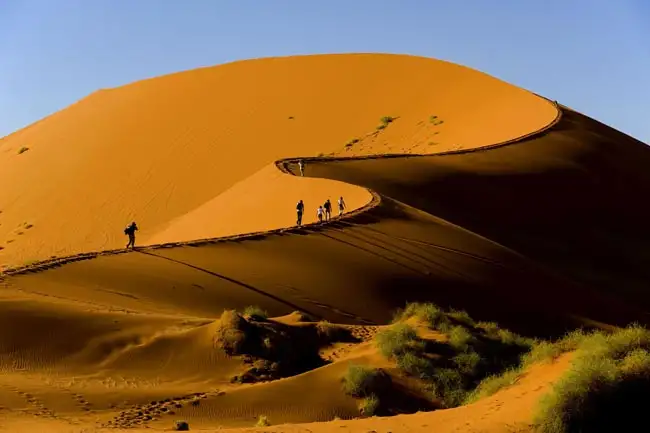
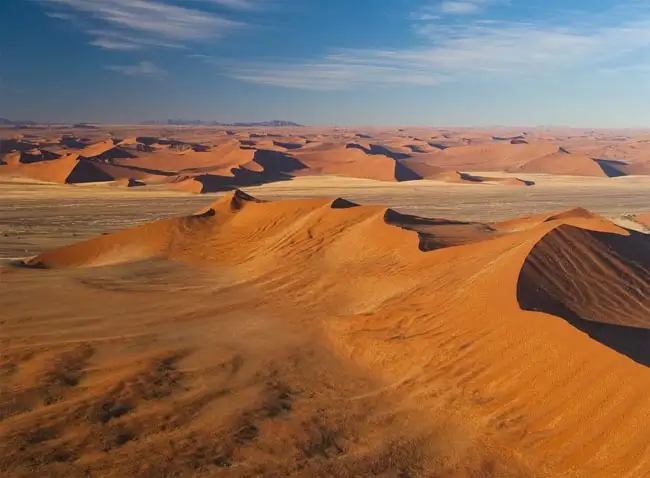
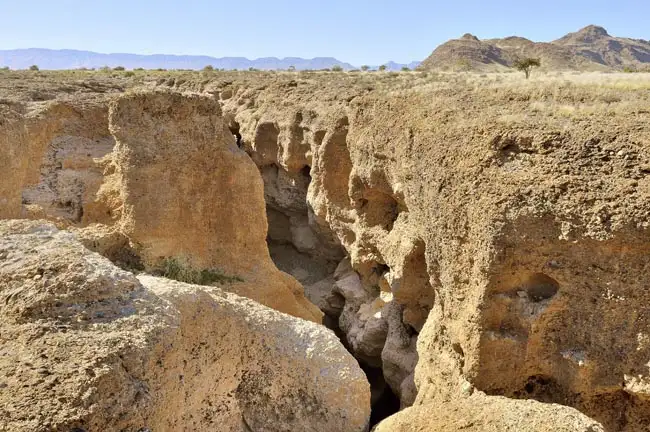
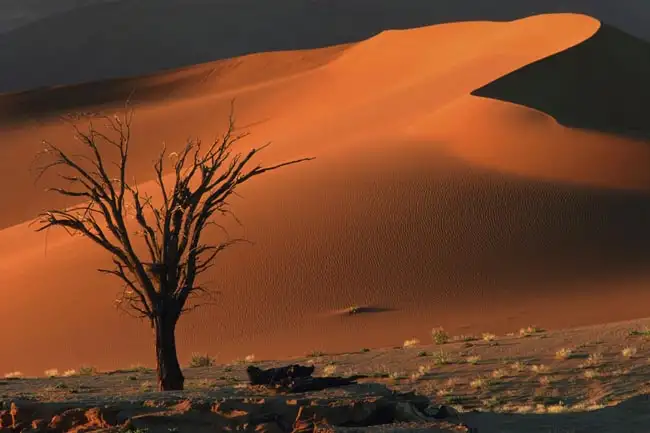
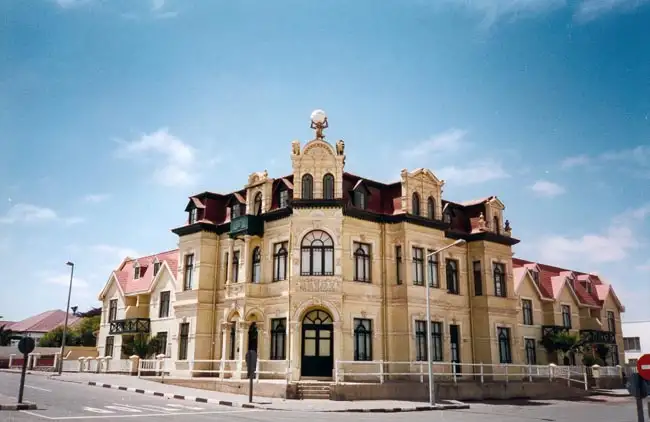
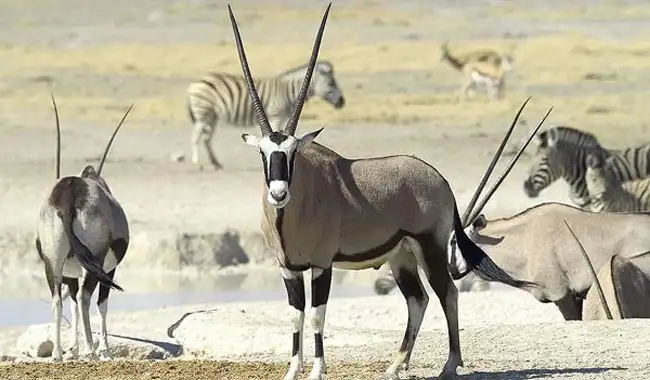
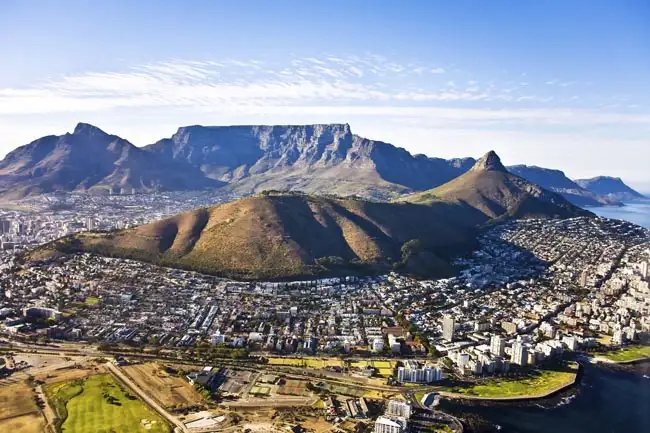
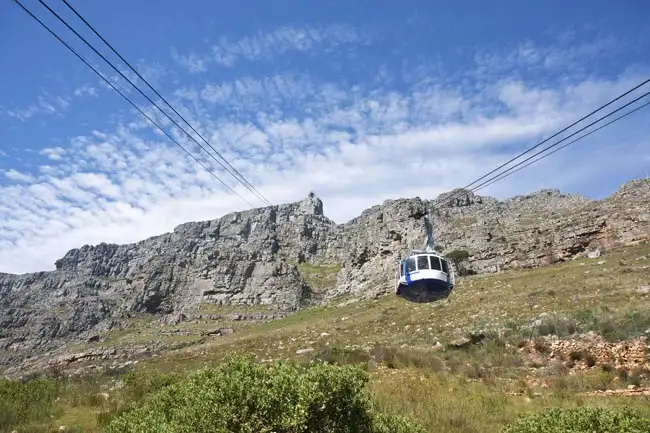
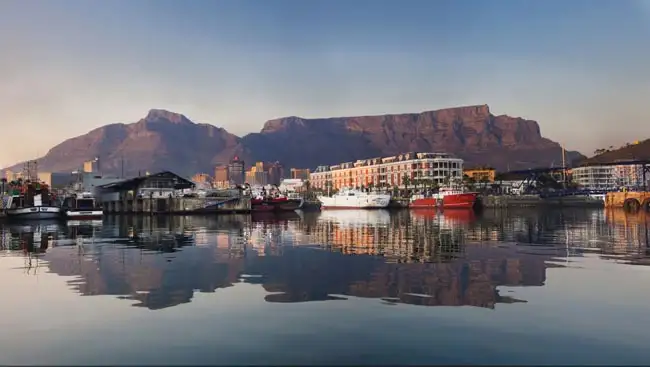
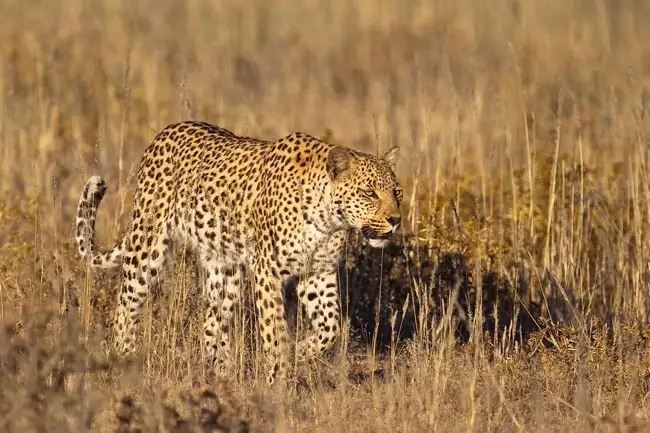
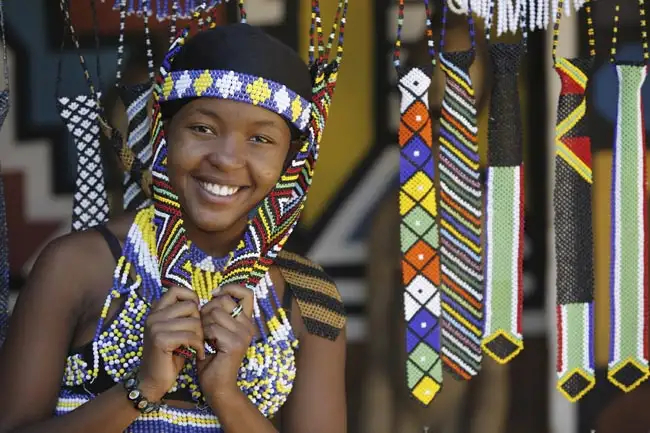
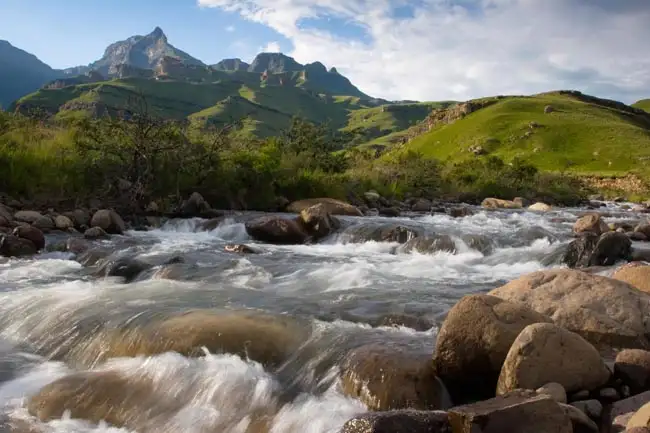
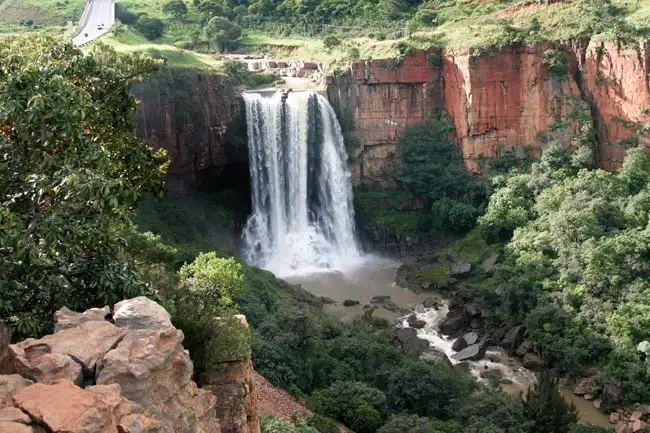
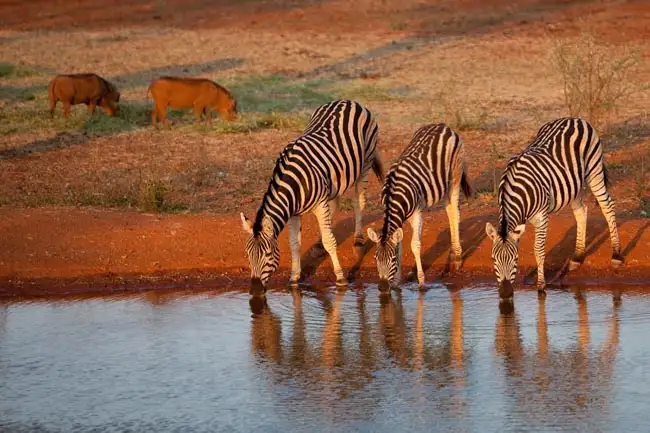
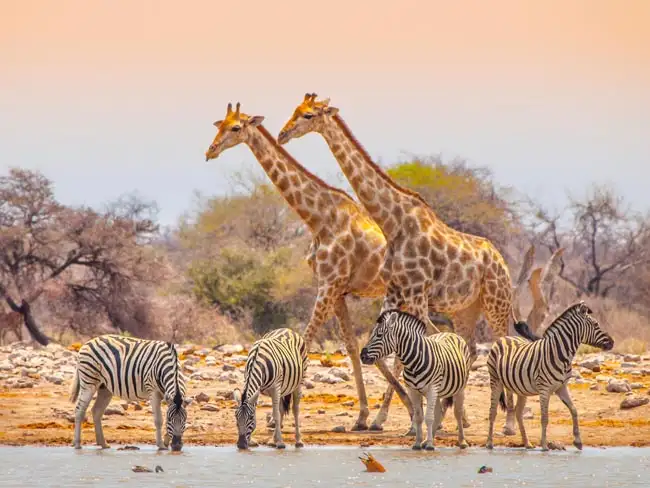
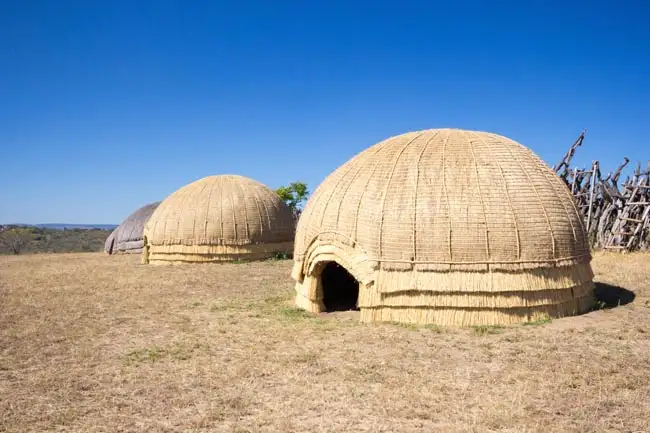
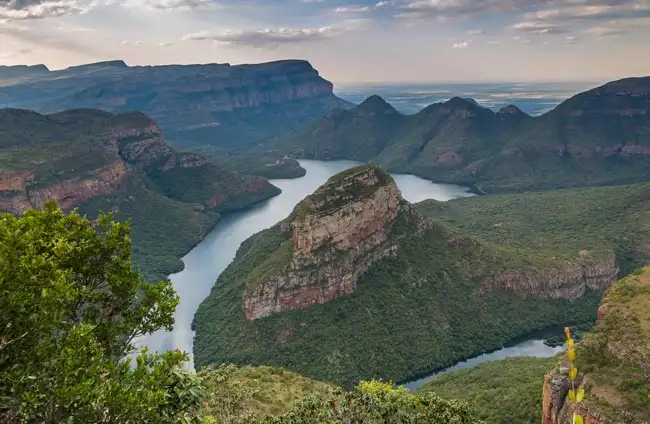
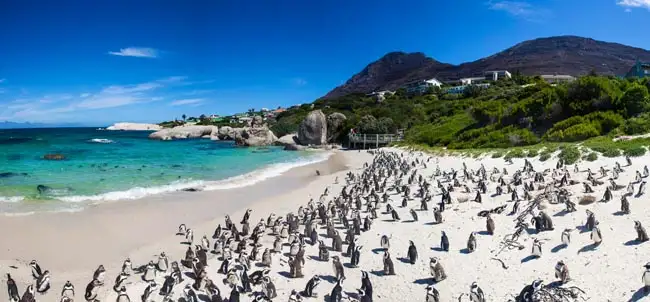
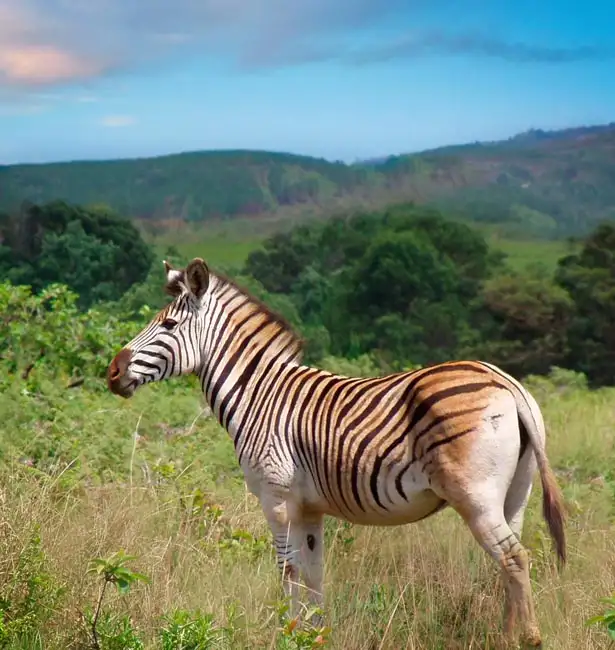
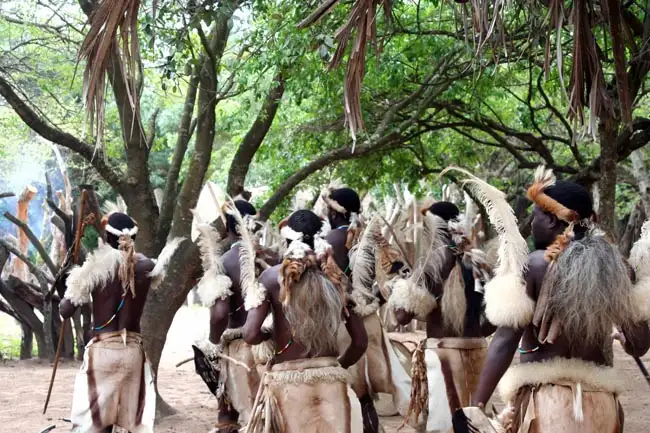
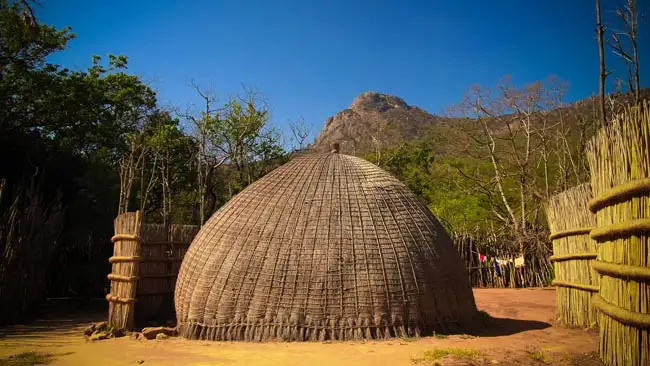
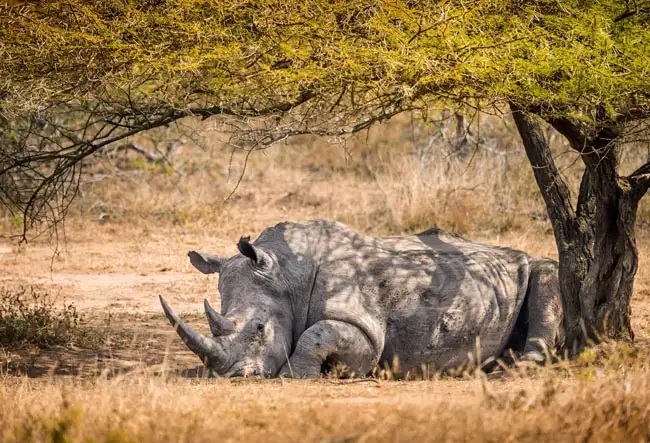
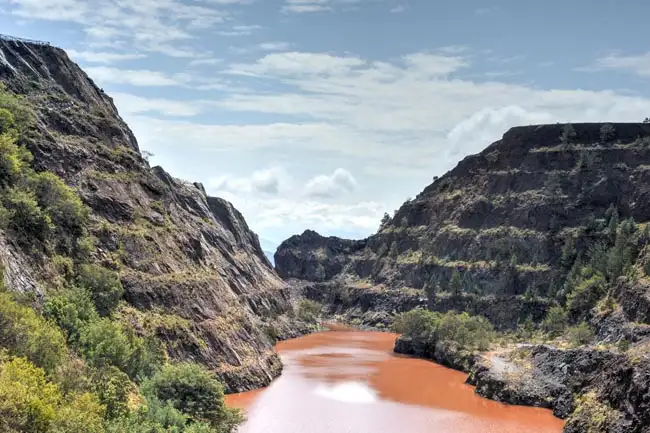
Excellent
Overall Rating
4.6
Extend Your Trip
This tour is part of a series that can be upgraded to make for a longer trip.
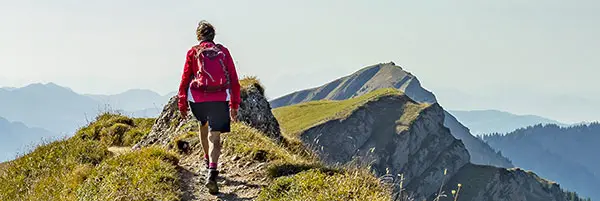
Fast and easy
Book this tour
Book your unforgettable adventure today! For any questions or advice, don't hesitate to contact us.
Have questions?
Contact Us
1-800-665-3998
- Final payment is due 90 days prior to departure.
- A non-refundable $500 USD deposit is payable at the time of booking
- Optional Single Supplement: $1880 USD (number of singles limited).
This tour may require a mandatory single supplement charge of $940 USD if you join our share program and we are unable to pair you. - Transferring to another tour or tour date is only permissible outside of 120 days prior to departure and is subject to a $100 USD change fee. (Read our cancellation policy for more info.)
- $1000 DEPOSIT REQUIRED due to Namibia accommodation which needs to be paid in full well in advance.
Prices below are per person, twin-sharing costs in US Dollars (USD). Pricing does not include airfare to/from the tour and any applicable taxes. Get general information on flights to/from the tour.
Choose your departure date:
Frequently Asked Questions
- What is the maximum number of participants on a trip?Most of our tours carry a maximum of 18 participants; some tours (ie hiking tours) top out at 16. In the event that we do not achieve our minimum complement by our 90-day deadline, we may offer group members the option of paying a "small-group surcharge" as an alternative to cancellation. If all group members agree, we will confirm the trip at existing numbers; this surcharge is refundable in the event that we ultimately achieve our regular minimum. If the small group surcharge is not accepted, we will offer a refund of your deposit or a different trip of your choice.
- Can I extend my tour either at the beginning or end? What about stopovers?Yes, you can extend your tour either at the beginning or the end and we can book accommodation in our tour hotel. Stopovers are often permitted, depending on air routing. Stopovers usually carry a "stopover" fee levied by the airline.
- How do I make a reservation? How and when do I pay?The easiest way to make a reservation is via our website; during office hours, you are also more than welcome to contact us by telephone.
A non-refundable deposit is payable at the time of booking; if a reservation is made within 90 days, full payment is required. Some trips require a larger deposit. If international airline bookings require a non-refundable payment in order to secure space or the lowest available fare, we will require an increase in deposit equal to the cost of the ticket(s).
Early enrolment is always encouraged as group size is limited and some trips require greater preparation time.
Once we have received your deposit, we will confirm your space and send you a confirmation package containing your trip itinerary, any visa/travel permit related documents, invoice, clothing and equipment recommendations, general information on your destination(s), and forms for you to complete, sign and return to us. Your air e-tickets (if applicable), final hotel list, final trip itinerary, and instructions on how to join your tour, will be sent approximately 2-3 weeks prior to departure. - What about cancellations, refunds, and transfers?Please review our cancellation policy page for details.
- I am a single who prefers my own room. What is a single supplement?All of our tours have a single supplement for those who want to be guaranteed their own room at each location.
This supplement is a reflection of the fact that most hotels around the world do not discount the regular twin-share rate for a room by 50% for only one person occupying a room. Most hotels will give a break on the price, but usually in the range of 25-30% of the twin-share rate. This difference, multiplied by each night, amounts to the single supplement.
The conventional amount can also vary from country to country and some destinations are more expensive than others for single occupancy. In order to be "single friendly," the supplements we apply are not a profit centre for us and we do our best to keep them as reasonable as possible.
On most tours we limit the number of singles available, not to be punitive, but rather because many hotels allow for only a limited number of singles; some smaller hotels at remote locations also have a limited number of single rooms available.
Please note that most single rooms around the world are smaller than twin-share rooms and will likely have only one bed. - Do you have a shared accommodation program?Yes! If you are single traveller and are willing to share, we will do our best to pair you with a same-gender roommate. On most of our tours, if we fail to pair you, we will absorb the single supplement fee and you will default to a single room at no extra charge. At some destinations, however, where single rooms are not significantly discounted, or not at all, we may apply a "mandatory" single in the event that we cannot find you a share partner. This is usually 50% of the usual supplement, but can be as much as 100%. If applicable, this proviso will be noted on each tour page on this website, on your invoice, and in our tour date/price book (available for download under "Resources").
Please choose a departure date!
